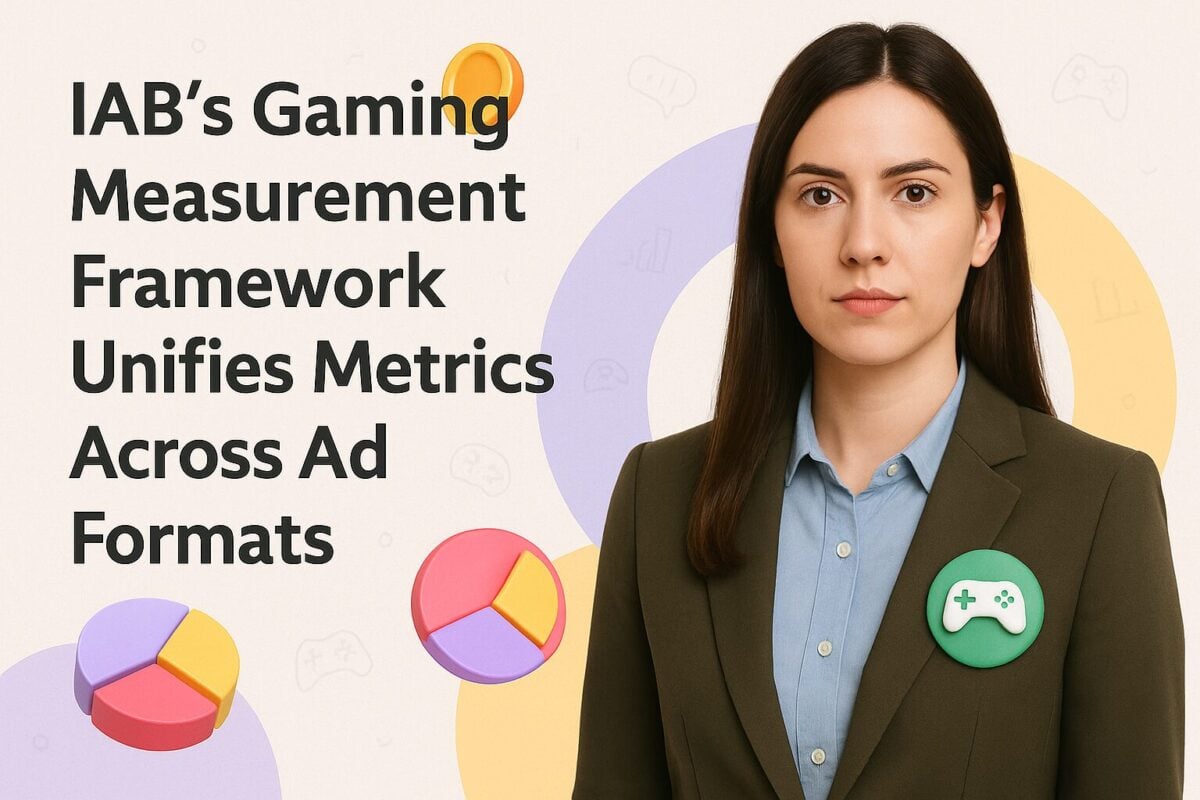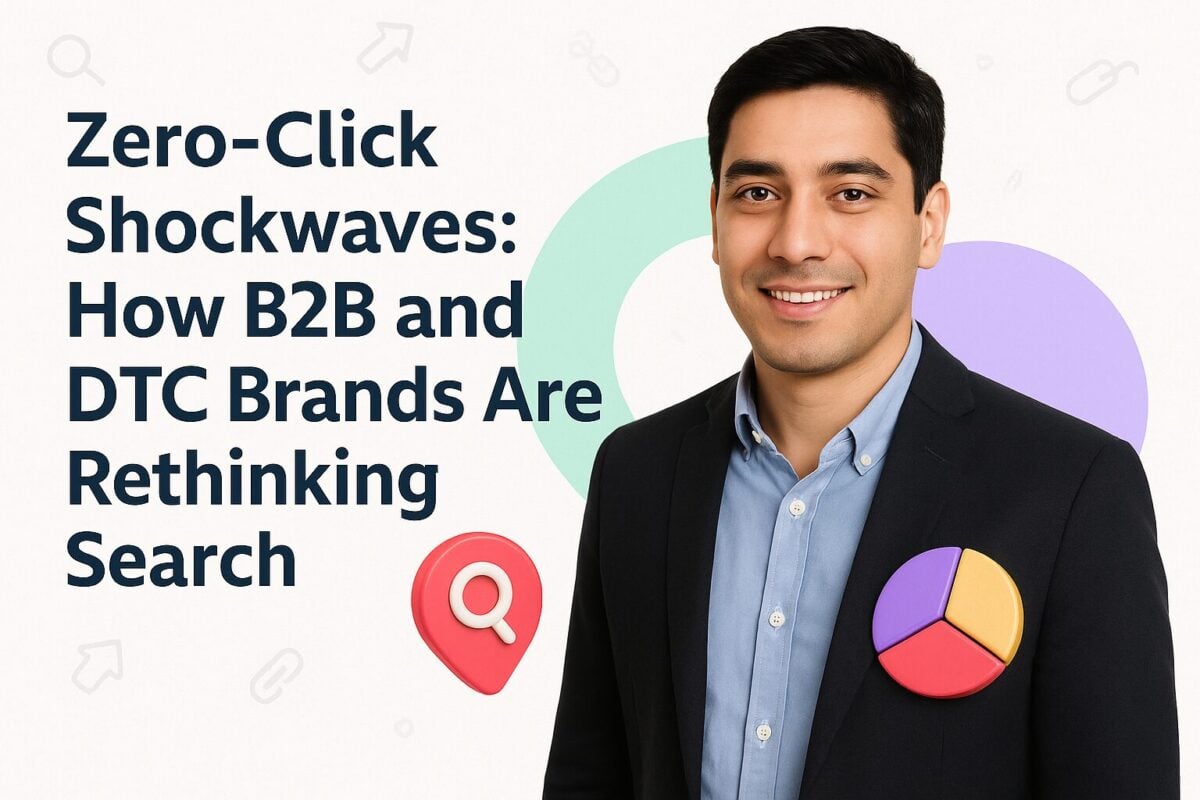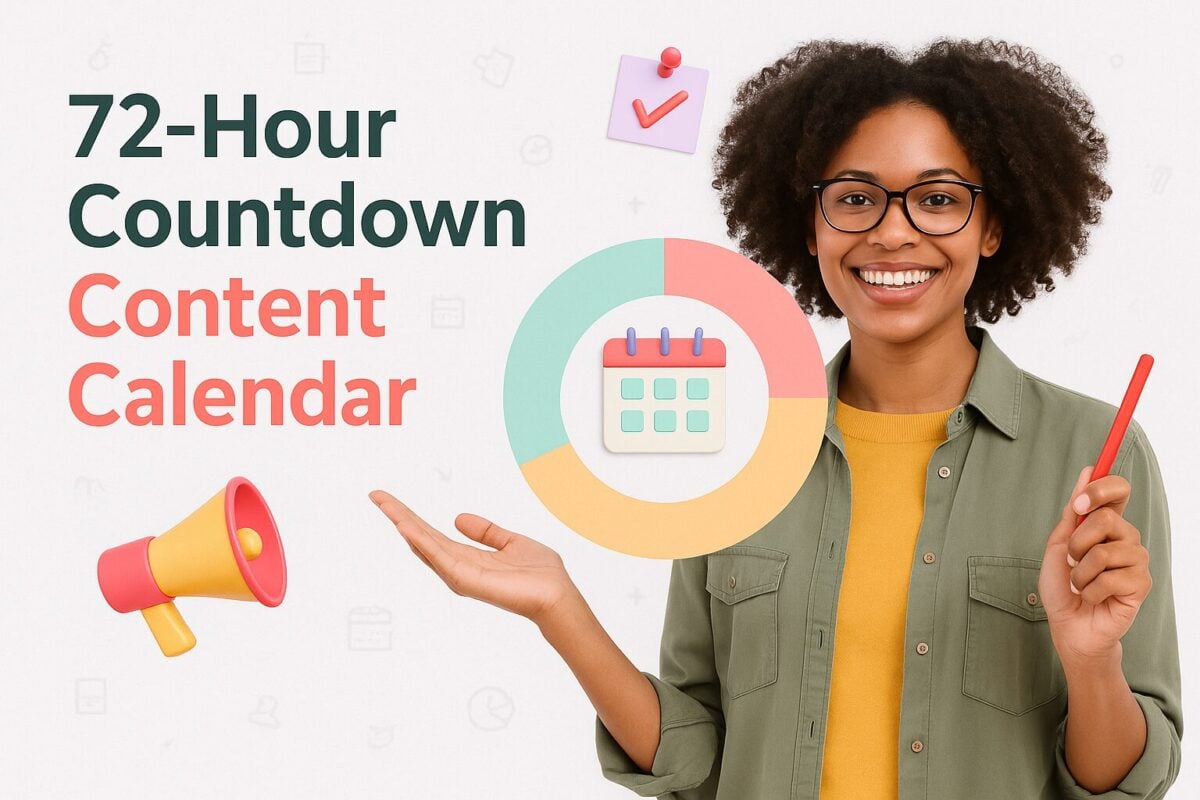Marketers often fall into the trap of focusing most of their marketing efforts at customers that are ready to buy. As it’s easy to measure the results, it also makes it easier to motivate their spending on ads, influencer partnerships, etc.
However, with marketing, you need to force yourself to play the long game too. You’ll need to design campaigns that speak to potential customers who are far from ready to buy too.
It’s a tough balancing act. No doubt.
Enter full-funnel marketing. It lets you leverage the benefits of brand building with performance marketing, helping you to improve your return on ad spend and resonate with both new customers as well as loyal brand fans.
Before you can go full funnel, though, you’ll first need to understand the different stages involved. Here’s a closer look at what the typical funnel looks like, ideas for each stage, and a few practical tips that can help you along the (whole) way.
What is Full-Funnel Marketing?
Full-funnel marketing involves developing a marketing strategy for each stage of the marketing funnel — top of the funnel (ToFu), middle of the funnel (MoFu), and bottom of the funnel (BoFu). It ensures that the customer enjoys a unified and consistent experience interacting with your brand throughout all these stages — from discovering your brand to buying your products and beyond.
Traditional marketing takes a more disjointed approach to marketing, where strategies may focus on simply raising brand awareness or generating sales. Meanwhile, full-funnel marketing takes an interconnected approach with strategies built for every stage of the marketing funnel, guiding customers seamlessly toward the usual path to purchase.
This helps you boost brand recognition in a landscape that’s increasingly competitive and saturated. It ensures that customers aren’t distracted by the wealth of options and, instead, gradually nurtured and eased into buying your products.
Marketing Funnel vs. Sales Funnel
When we talk about full-funnel marketing, it’s important to make a clear distinction between the marketing funnel and the sales funnel. The marketing funnel is related to customer interactions as a whole — starting from the moment they become aware of your brand to the moment they become leads. It may involve various ways in which they interact with your brand, such as discovering your brand’s post on social media, reading your blog posts, or seeing your YouTube ad.
Meanwhile, the sales funnel refers to your brand’s relationship with people who’ve already gone through the various marketing channels and are now leads who could potentially become customers. In other words, the sales funnel focuses on people who are already aware of your brand and need a bit more convincing to choose your brand over the competition. For example, a digital marketing sales funnel may focus on nurturing leads through free demos and email promo offers.
It's easy to confuse the two because there are some overlaps. But the easiest way to understand the difference is that the sales funnel comes after the marketing funnel.
Stages of the Full-Funnel Marketing Strategy
To get a better understanding of how a full-funnel marketing strategy works, let’s break down each stage further.
Top of the Funnel (TOFU) – Awareness
- Objective: Attract a wide audience and generate awareness
- Tactics: Content marketing, social media, SEO, paid ads, influencer marketing
- Examples: Blog posts, social media campaigns, public speaking engagements
- Metrics: Impressions, reach, engagement
The top of the marketing funnel focuses on building brand awareness. It involves having an effective brand marketing strategy to reach customers who may not know about your brand yet.
As a result, your top-of-the-funnel strategy will aim to reach target audiences through the channels that they use the most. This may include running search ads to get your brand in front of people who are searching for related keywords. Similarly, other types of digital ads and ads through traditional mediums like television and radio are all a part of top-of-the-funnel marketing.
Brands may also develop influencer marketing strategies to help them grow awareness. However, top-of-the-funnel strategies don’t always have to involve paid advertising campaigns. In fact, brands can also generate TOFU awareness through search engine optimization, which involves boosting organic visibility in relevant search engine results.
“Over 90% of the time, our team starts with SEO, cold outreach, and rapid lead acquisition campaigns,”
says Ivan Burban, Head of Marketing at Coupler.io.
“By doing these, we promote previously prepared, useful and targeted content of various types, establish a stable flow of traffic to our website, and high positions of our content.”
Real-Word Success Story
In the following example, Mailchimp uses a Google ad to showcase their brand to people who are searching for “email marketing tools.” That way, someone who needs an email marketing tool but has never heard of the brand before will now learn that Mailchimp offers the solutions they need.
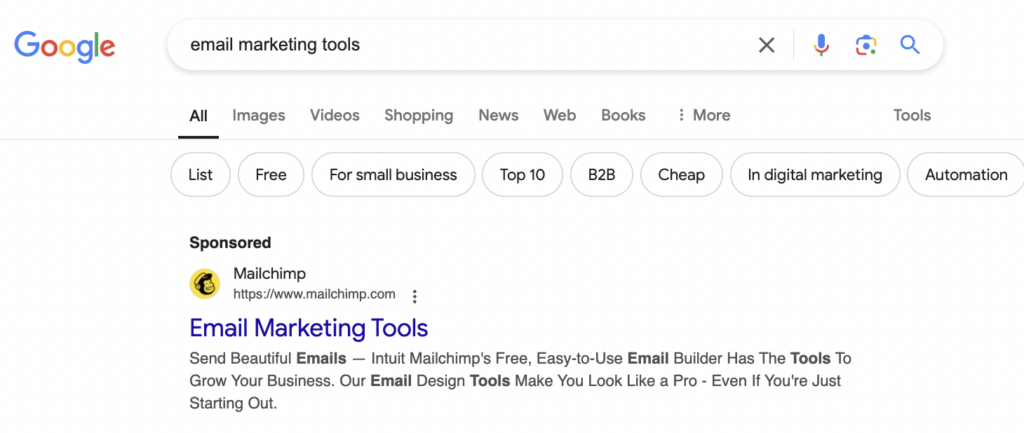
Source: google.com
Middle of the Funnel (MOFU) – Consideration
- Objective: Engage and educate potential customers
- Tactics: Email marketing, webinars, case studies
- Examples: Detailed guides, whitepapers, email newsletters
- Metrics: Click-through rates, time on site, lead generation
The middle of the funnel focuses on marketing to people who already know about your brand. At this stage, however, your brand isn’t yet at the top of their minds while they look around for the solution to their problem. Or they may not yet have enough understanding to consider how your brand solves their problem. So this is where you apply lead generation strategies to ensure that those people become leads.
MOFU marketing is all about showing people why they should choose you. It’s about presenting your brand and products as a viable solution to their problem.
This can be through insightful and informative content that addresses their pain points. Think of webinars, data reports, comprehensive guides, and email newsletters to share information that would guide people to the solution they need.
Real-World Success Story
Currys creates in-depth buying guides to help improve understanding of the company’s home appliances and tech products. These guides break down things like varieties, size, features, and other considerations to help customers better understand what they need in that specific product category.
By doing this, Currys gives customers the knowledge they need to confidently choose the right products. At the same time, they present themselves as experts in the field, making them the go-to destination for customers looking to buy those products.
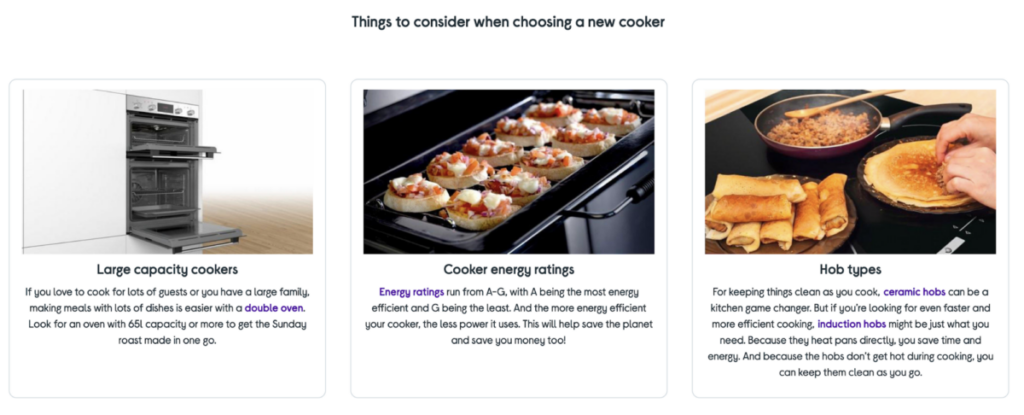
Source: currys.co.uk
Bottom of the Funnel (BOFU) – Conversion
- Objective: Convert leads into customers
- Tactics: Free trials, product demos, personalized offers, social proof
- Examples: Special discounts, personalized emails, sales calls, testimonials, customer reviews
- Metrics: Conversion rates, cost per acquisition, sales revenue
The bottom of the funnel is where you finally get people to buy your products or services. At this stage, you’re trying to reach people who are likely already convinced but just need that final nudge to take the plunge.
BOFU marketing is all about giving them the confidence to finalize their purchase. Depending on what you’re selling, you may need to use social proof like case studies, reviews, and testimonials to inspire that decision. You can even sweeten the deal with free trials, discounts, coupons, and other attractive offers.
Real-World Success Story
PIXI sent the following email promoting an exclusive friends and family sale with a coupon code for 20% off everything on the site. The email also includes customer reviews for certain product ranges to inspire purchase decisions. While the attractive discount may entice people to make a purchase, the addition of customer reviews for specific product ranges may inspire them to use the discount coupon on those products.
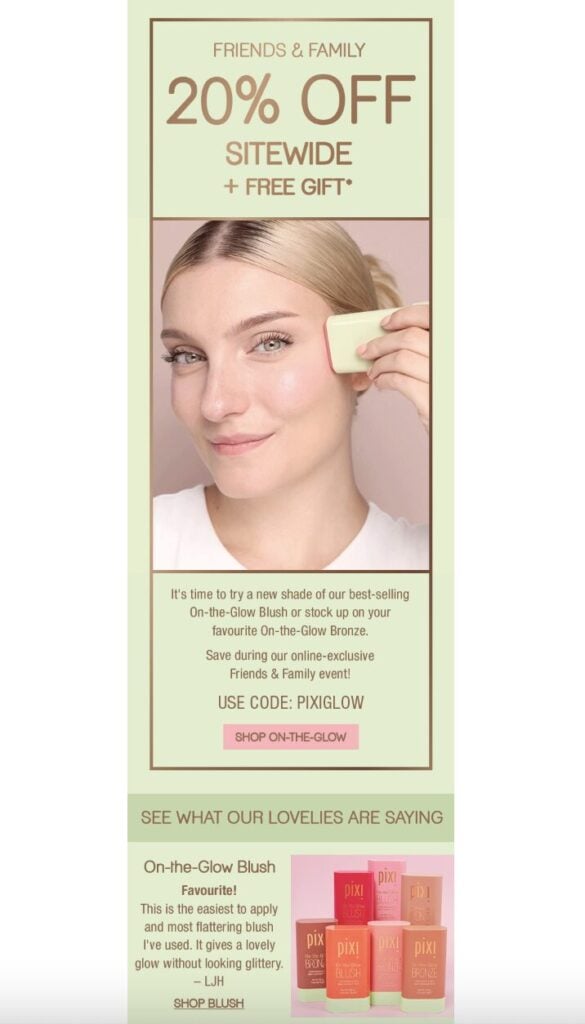
Post-Purchase – Loyalty and Advocacy
- Objective: Retain customers and turn them into advocates
- Tactics: Customer success programs, loyalty rewards, referral programs
- Examples: Follow-up emails, loyalty programs, referral incentives
- Metrics: Customer retention rates, customer lifetime value, net promoter score
Some “full-funnel” strategies may focus on marketing to customers up until they end up buying. However, your marketing isn’t exactly complete only because someone buys something. You also have to extend your marketing efforts to the post-purchase or post-funnel experience so you can retain the customers who’ve already converted.
This is crucial because you have a better chance of convincing your existing customers to buy than you do at converting a new audience. In fact, the chances of converting an existing customer is 60-70%, while the odds drop to 20% for new customers.
Post-funnel marketing is all about nurturing your existing customer relationships to build loyalty and drive repeat purchases. So you may set up loyalty programs where customers earn rewards for every purchase. Additionally, the post-purchase experience is also crucial for encouraging brand advocacy so you can win more customers through positive word-of-mouth. So you may have referral programs and offer incentives for successful referrals.
Real-World Success Story
The Dropbox referral program is one of the leading examples of post-funnel marketing. It allows customers to earn free space for every successful referral. This simple approach helped the company achieve 3,900% growth within 15 months of the program’s launch.
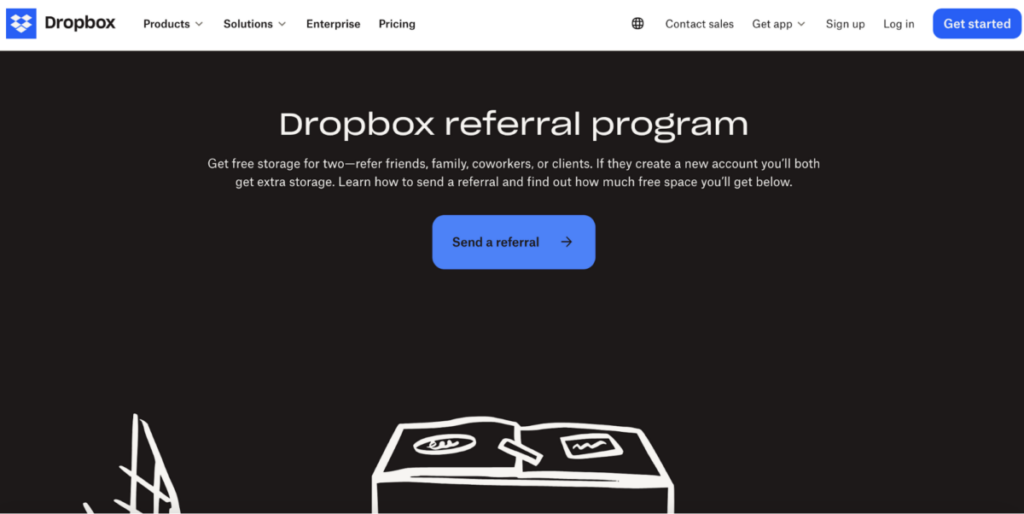
Source: dropbox.com
Benefits of a Full-Funnel Marketing Strategy
As we briefly discussed earlier, a full-funnel marketing strategy allows businesses to build brand recognition through consistent brand experiences. But the benefits extend far beyond this. Let’s break down the key benefits of having a full-funnel marketing strategy.
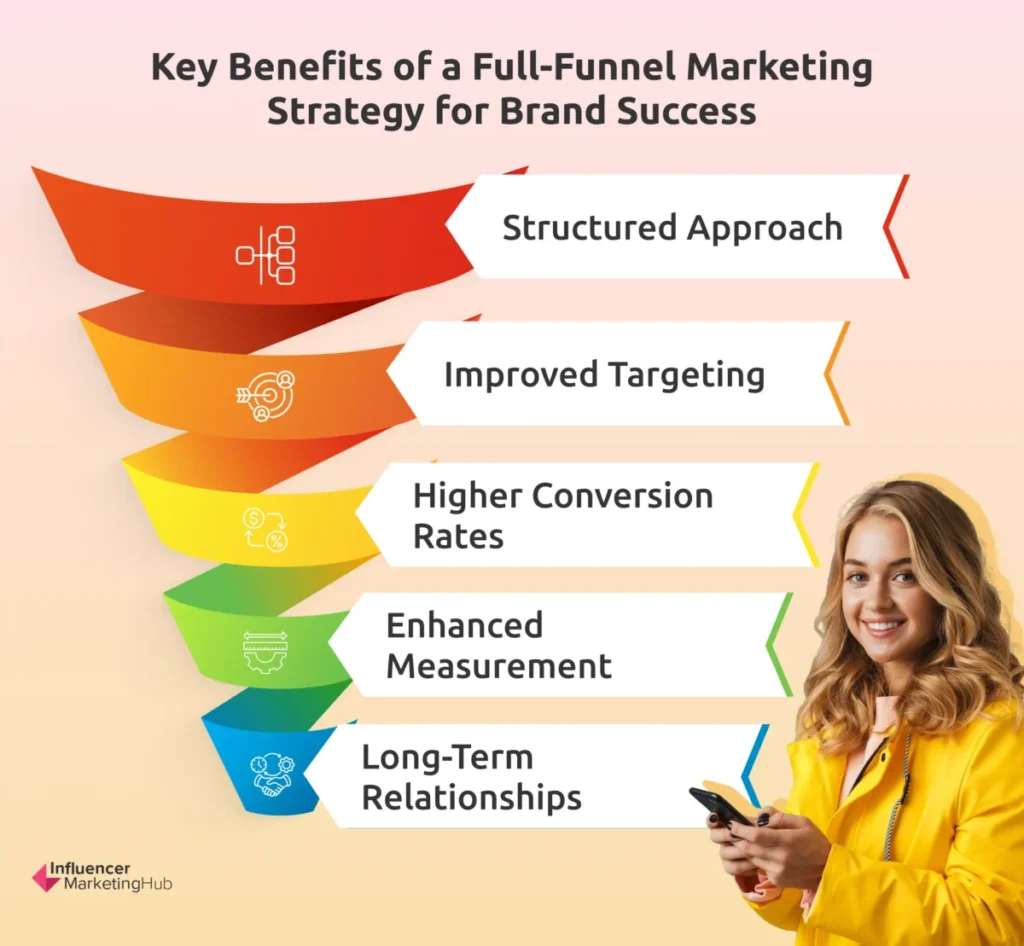
1. Structured Approach
When you have a full-funnel marketing strategy in place, you have a systematic way of guiding prospects through the customer journey. It helps you take a structured approach to marketing so that your digital marketing strategies don’t feel disjointed. You can map out how to address customers’ needs at every stage of the funnel and how to connect these experiences.
2. Improved Targeting
With full-funnel marketing, you’re creating tailored experiences to address the unique needs and pain points of customers at each stage of the marketing funnel. This ensures that your marketing efforts are relevant to all types of shoppers, even if they’re entering the funnel in the middle. So you can enhance your targeting and engage more customers across various touchpoints.
3. Higher Conversion Rates
A full-funnel marketing strategy allows you to nurture prospects once they enter into the funnel. Instead of simply leaving them be and hoping they’ll naturally follow the path to conversion, you’re gradually guiding them through experiences that they need. This gives them the confidence to convert, helping you boost conversion rates.
4. Enhanced Measurement
When you take a structured approach to marketing, you have a clear set of metrics to measure your performance at every stage of the funnel. This makes it easier to focus on the right metrics and continuously optimize your efforts.
5. Long-Term Relationships
Full-funnel marketing focuses on building lasting relationships with customers. Instead of simply converting customers, a full-funnel strategy ensures that customers are nurtured after going through the various marketing funnels. It involves using various strategies to nurture customer loyalty and drive repeat purchases.
How to Create a Full-Funnel Marketing Strategy
Now that you’ve understood what goes into a full-funnel marketing strategy and why you need it let’s get into the practical aspects of this guide. But before that, make sure to check out our guide on how to build a marketing funnel. Then follow the steps below to create a full-funnel marketing strategy for your business.
Step 1: Define Your Target Audience
As always, you need to start with a clear idea of who your target audience is. When your audience is well-defined, you know exactly who you want to reach and how to reach them. That way, you can map out the various journeys they take throughout different stages of the marketing funnel.
This is a crucial step to figure out how they consume content, which channels they use, and more. So you can discover meaningful touchpoints that will guide your full-funnel strategy.
To define your target audience, start by identifying your key demographics. You can use your social media audience reports to check out the demographics of people who follow your brand. Check out our guide on how to find your target audience on social media for more detailed steps.
Once you know the key demographics, you can use audience research software to further understand their needs and behaviors. For example, you can use Similarweb to see which websites they browse, what their interests are, and more so you can figure out how to effectively engage your target audience.
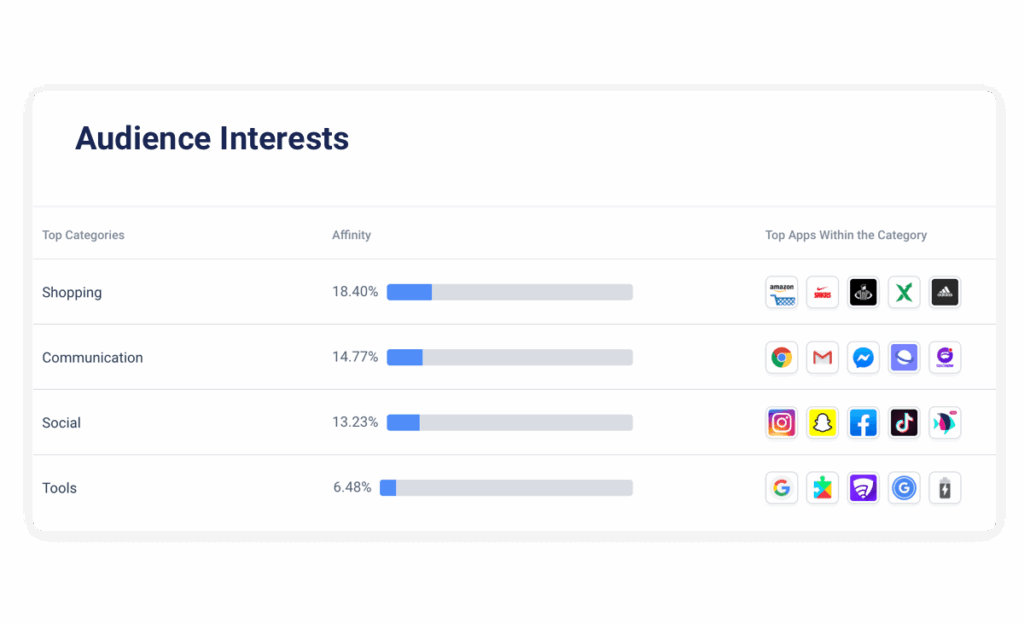
Source: similarweb.com
Use the insights from your audience research to create detailed buyer personas, segmenting customer groups based on shared characteristics. This will allow you to build targeted marketing strategies that appeal to different types of people.
You can simplify the process using platforms like Audiense, which uses AI and machine learning to automatically create audience segments based on interconnectedness. This means that the audience is segmented based on shared affinity. So people who enjoy content from Grub Street and NYT Food will be under the same segment, while Runner’s World fans will be categorized into a separate segment.

Step 2: Develop Content for Each Funnel Stage
After you have your target audience set up, you’ll want to start creating content for every stage of the funnel. You can employ different types of content marketing in this process to ensure that you’re appealing to various types of audiences at each stage.
“We can ensure there is a seamless transition by creating a clear customer journey map and aligning our content and messaging for each stage of the funnel,”
advises Pankaj Kumar, Director at Naxisweb.
“This entails giving leads the necessary information to nurture them and addressing their pain points at stages of the funnel. Such include educational content that is used to create awareness, detailed product comparison for consideration, and limited offers or testimonials as well as purchase decisions.”
Create Awareness Content
- Blog Posts – Blog posts help you discuss topics that are of general interest to the audience and address a major pain point. They can be optimized for visibility in relevant search engine results, helping you attract customers from organic search. Moreover, they may be shared amongst peers to further boost reach. This makes them great for awareness content as you can reach people who are looking for relevant information but may not yet be aware of your brand.
- Social Media Posts – Social media is one of the leading ways that people discover new products — whether it’s through a brand’s organic post, a social media ad, or a post shared by a friend. Forbes even reports that 24% of consumers primarily use social media to conduct their online searches. So creating engaging social media posts is one of the best ways to build awareness.
Focus on engaging content formats like short-form videos and visuals that people will want to engage with. Make sure you offer value through the content you share — whether it’s by informing, educating, or even entertaining the audience. - Press Releases – You can also use press releases to get the word out about your brand through third-party channels. Focus on newsworthy topics and share them through publications that your target audience frequently reads.
- Data Reports – Data reports containing original research are a great way to establish unique value. You can attract people who are seeking out data-backed insights and information to learn more about the industry. Plus, they’re highly likely to attract backlinks from reliable sources that want to back up their claims. This way, you attract valuable traffic consisting of people who may be willing to learn more about your brand.
- Paid Advertising Content – Your TOFU strategy can also leverage paid advertising content to further amplify your reach. Use targeted strategies to reach highly relevant users through search ads, social media ads, podcast ads, influencer sponsorships, and more.
Develop Consideration Content
- Webinars – Webinars let you share educational information that’s valuable to people in the consideration stage. In fact, 46% of marketers consider them the most effective channel for generating demand. You can use webinars to share your expertise, conduct interviews, host a panel discussion, demonstrate your products, analyze the latest market trends, and more.
- Case Studies – Case studies allow you to show proof of what you can do for your customers and the value that you can provide. This makes them a great option for MOFU marketing, as you can showcase your capabilities through real-life results, which will entice people to consider your solution.
- Whitepapers/In-Depth Guides – Develop whitepapers with in-depth guides showing people how to do something, use a product, or solve a problem. When you create in-depth guides to address a major pain point, you can provide value to your audience while effectively showcasing what you’re capable of.
You show your audience that you know exactly what to do, establishing yourself as a reliable source of information. So when they’re confident enough to seek out a solution, your brand stays at the top of their minds.
Design Conversion Content
- Testimonials/Reviews – Testimonials and customer reviews may sometimes be categorized as MOFU content. But they can also be used as effective conversion content as they provide powerful social proof that gives people the final nudge to make a buying decision. Seeing how other customers have benefited from your product or service can give them the confidence to finally go through with the purchase.
Share impactful testimonials through videos, visuals, and text. Highlight them on your website homepage, social media, or relevant product pages. - Free Trials - In the case of high-investment products such as technology solutions, customers may not be ready to make a purchase without first seeing what it feels like to use it. So it makes sense to offer free trials and give them the opportunity to take the product for a test drive. Alternatively, in the case of service offerings, free consultations and audits can help you tease your offering and give prospects a chance to see what it’s like to work with you.
- Demos – In some cases, customers might only need a better understanding of how the product works before they make a purchase. Consider providing free demos with detailed walkthroughs to help them understand the value that your product could bring.
Step 3: Utilize Multi-Platform Integration
Today’s customer buying journey is multichannel. Someone who’s never heard of your toothpaste brand might discover it when they search Google for “best toothpaste for sensitive teeth.” Even if they don’t buy it immediately, they might notice it again when someone they follow on Instagram shares their experience using it.
This might convince them to try it for themselves because: 1) they’re already familiar with it, and 2) someone they know has a positive experience using it. As people interact with your brand through various channels, they can take a number of potential paths to purchase.
So it’s crucial to take a multi-platform approach to full-funnel marketing. This simply means leveraging various online platforms to reach your audience at different stages of the funnel. It may include:
- TikTok
- YouTube
- Relevant online publications
In addition to maintaining an organic presence across various platforms, you can also leverage Performance Max (P-Max) campaigns to streamline your advertising. This lets you consolidate all your campaigns and promote your brand across the Google Network using one campaign. This can help you drive an average of 18% more conversions at a similar cost per action.
With this type of campaign, the Google AI serves your ads to the best potential customers based on budget, business goals, and conversion actions. It will also automatically optimize bids and placements to improve conversions. Make sure to closely monitor your results so you can further optimize your campaign with high-quality ad creative.
Step 4: Measure and Optimize
On a related note, it’s important to closely track the performance of your marketing strategies across various funnel stages. See which channels are paying off, which ones aren’t yielding results, what types of content resonate well, and more. This will provide you with insights to improve effectiveness at each stage.
For example, if you notice that your how-to videos are generating tons of engagement at the awareness stage, you might want to focus on creating more of them. Similarly, if a certain data report is helping you attract tons of viable leads, you could allocate more resources to promoting it. Think infographics and visuals to provide snippets and teasers, for instance.
Alternatively, you might notice that your Instagram ad isn’t generating a lot of traffic. You might consider playing around with the targeting and ad creative to see if it makes a difference.
You can make use of AI marketing analytics and tools to simplify the process. For instance, platforms like Insider will automatically analyze customer data and connect them across various touchpoints. These insights will inform how to optimize the customer journey for improved personalization and effectiveness.

Real World Success Stories
Semrush
Semrush has a powerful full-funnel marketing strategy that focuses on boosting brand awareness and retention through valuable content. Let’s break down the various strategies that contribute to the platform’s marketing success at different stages of the funnel.
TOFU
As a leader in all things SEO, it makes sense that Semrush will employ SEO in their top of the funnel strategy. The platform creates high-quality content that shares valuable information on topics related to SEO. And most of these blog posts rank on the first page of relevant search results, which is a clear indicator that they know what they’re doing.
For instance, the following blog post on on-page SEO has the featured snippet. This gives the brand significant visibility, which allows them to attract relevant traffic and increase brand awareness.

Source: google.com
If you look at the organic traffic for this page, it’s 12.6k per month. Out of those thousands of visits each month, it’s safe to assume that many of them will be potential users.
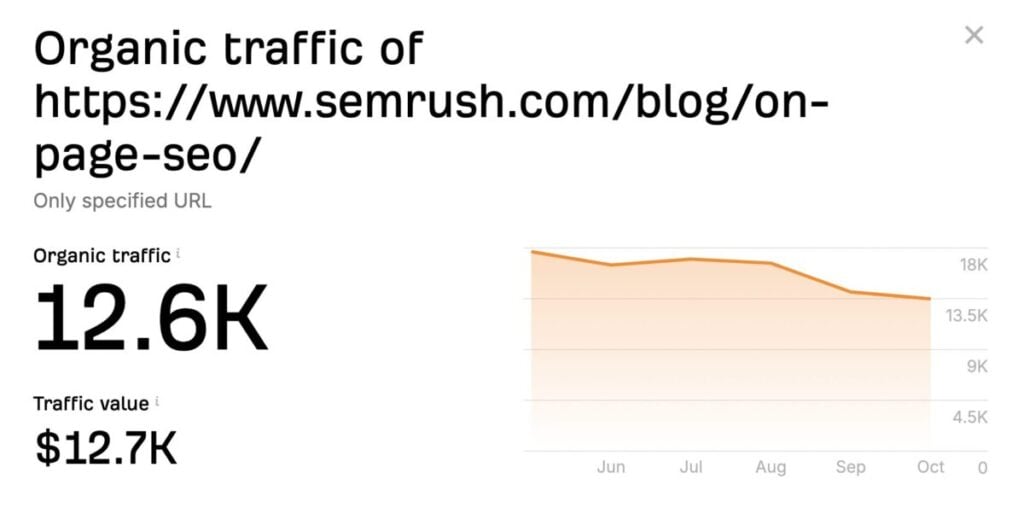
Source: ahrefs.com
MOFU
Education is the name of the game for Semrush, using in-depth guides to engage people and gradually nurture them as prospects in the middle of the funnel. At this stage, it’s less about getting them to use the platform but more about building a relationship with them.
In addition to their high-quality informational blog posts, Semrush also offers a series of resources that provide value to their audience. This includes original insights, webinars, and online courses that you can all access for free. Throughout all these, they impart valuable information, sometimes showing how Semrush’s solutions can be implemented for SEO success.
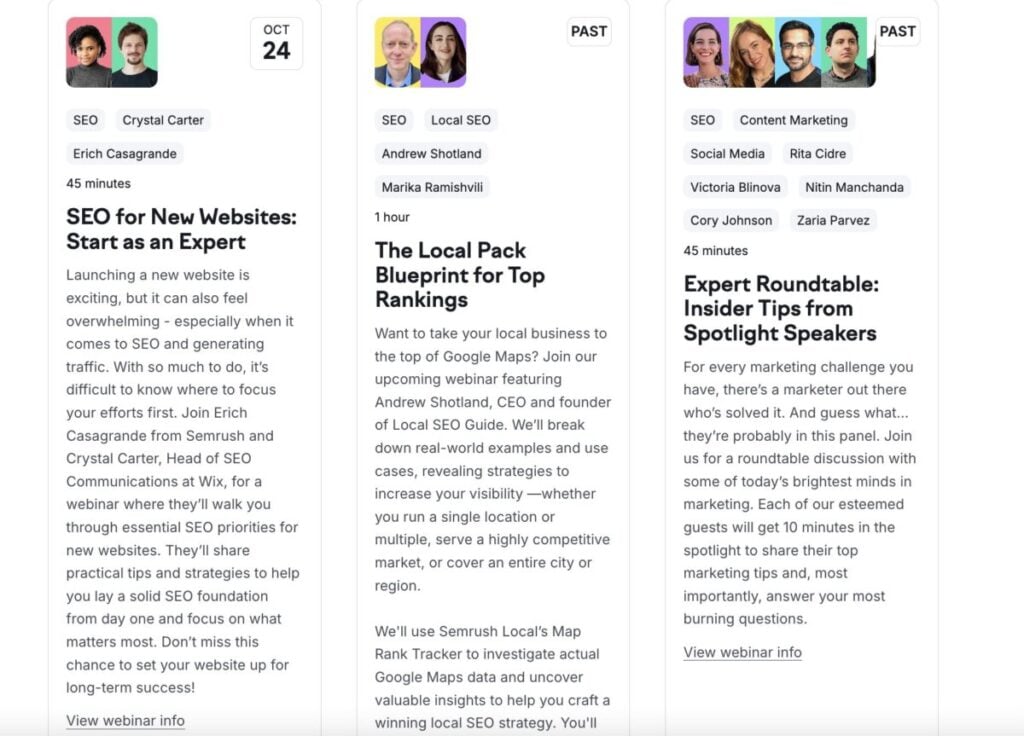
Source: semrush.com
BOFU
Semrush also entices users to convert by providing them with access to their tools for free. You can see the following pop-up encouraging visitors to sign up for a free account. This will create an opportunity to eventually nurture them into paying customers.
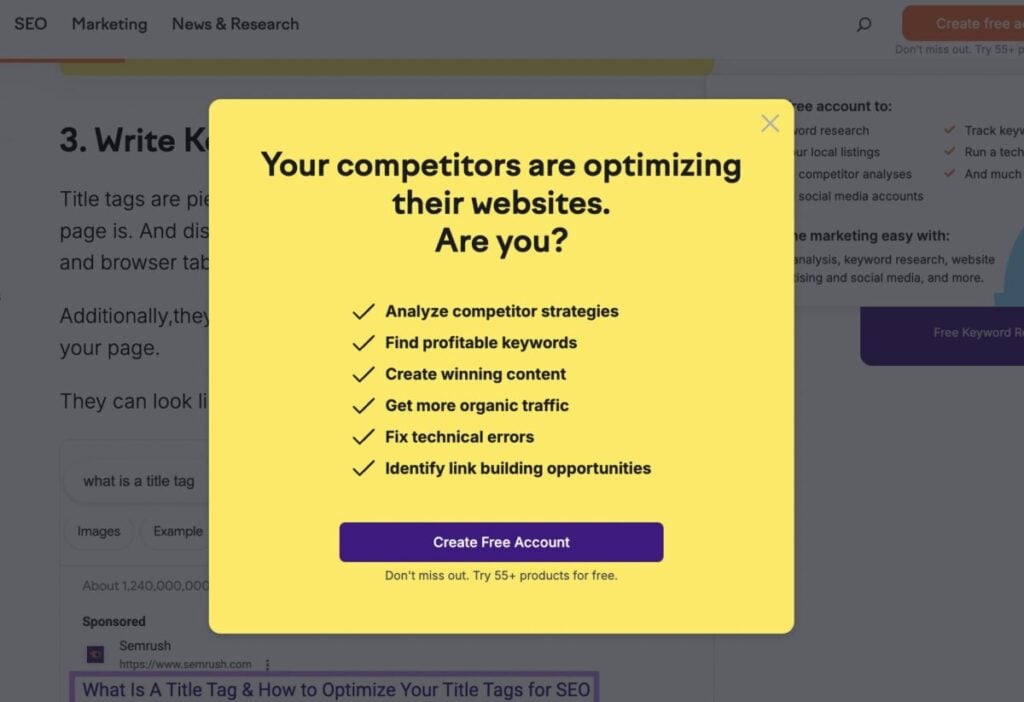
Source: semrush.com
People with access to the free account may get email offers like the one below. A 30% discount could encourage many free users to upgrade to a paid plan where they can gain access to more advanced features.
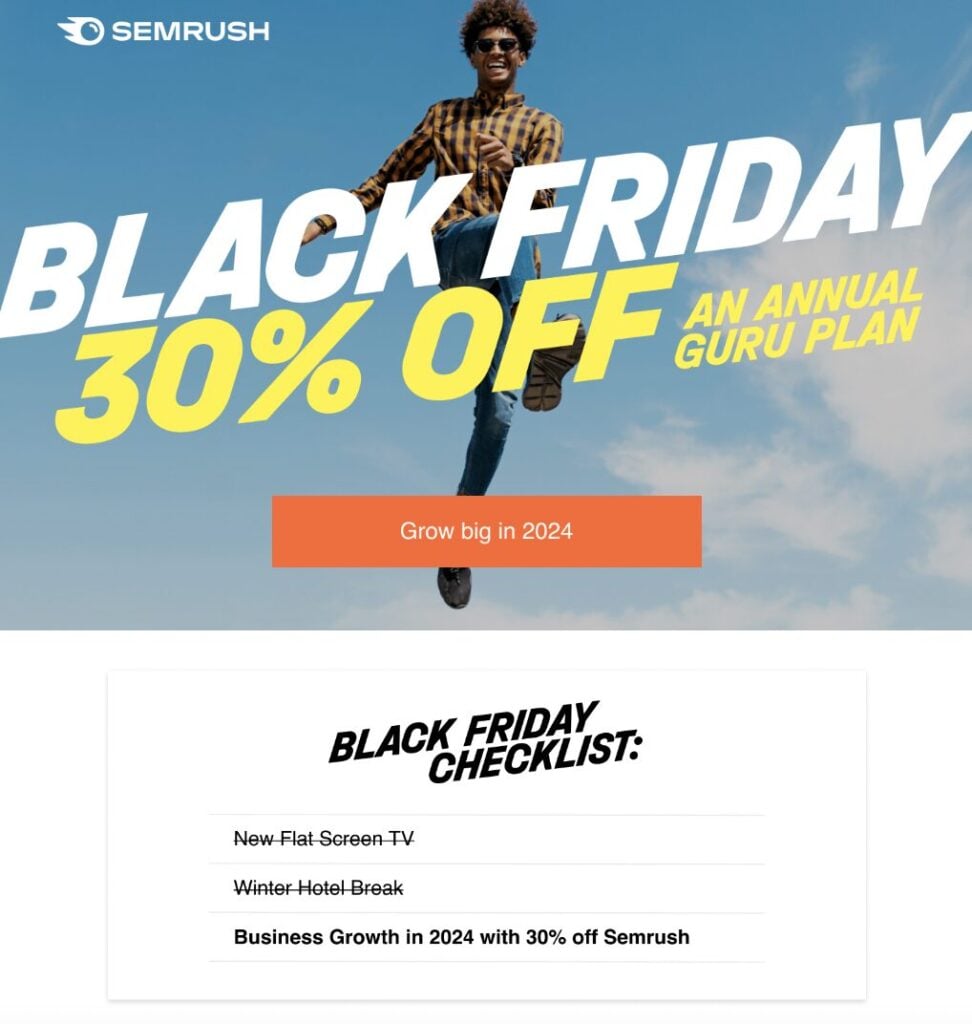
Grammarly
Grammarly is another full-funnel marketing success story, with effective strategies focused on delivering value for customers at every stage of the marketing funnel.
TOFU
Like Semrush, Grammarly also leverages SEO for their TOFU marketing. They produce educational content targeting people who are in search of spelling and grammar tips and optimize it for search. This includes content focused on common typos and grammar questions.
For instance, besides the Dictionary result, Grammarly holds the top position for search related to the “Oxford comma.” The high search visibility allows Grammarly to create awareness among people who might find value in their offering and become potential users.
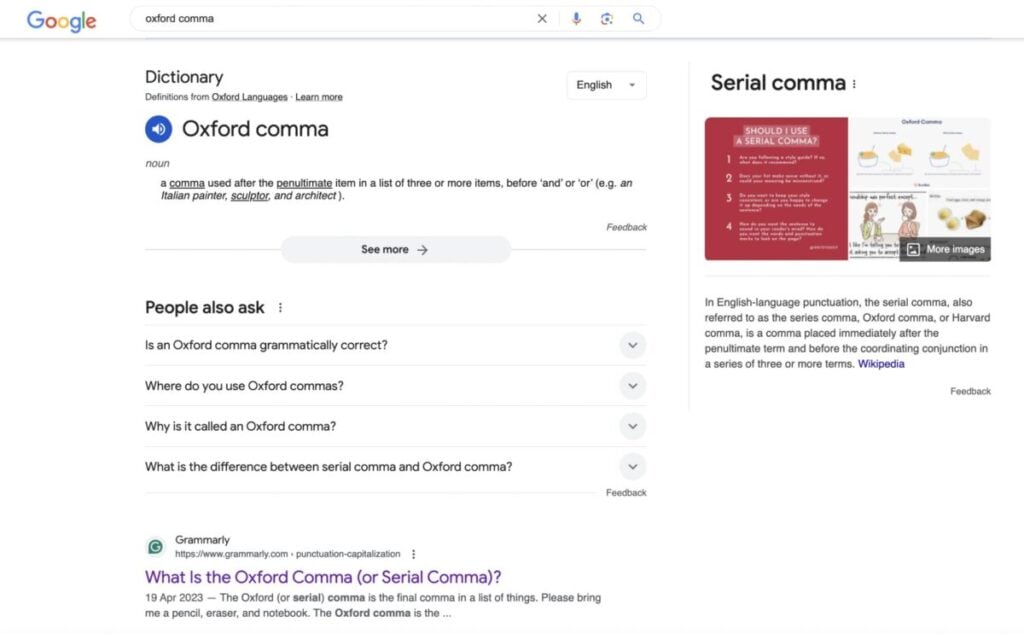
Source: google.com
MOFU
In the middle of the funnel, Grammarly immediately creates value by offering free access to their tools. They offer a bunch of free tools for checking grammar, checking plagiarism, and detecting AI.
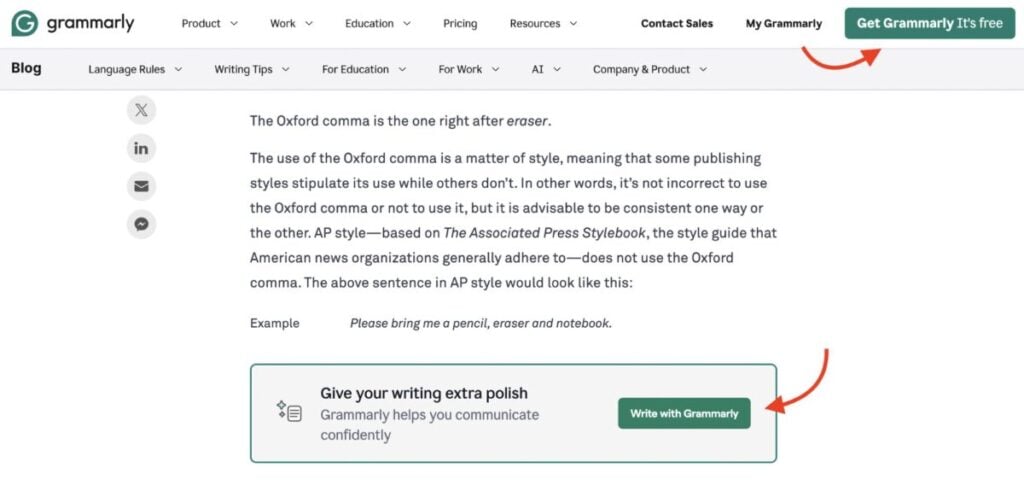
Source: grammarly.com
They even offer writing tools powered by generative AI — all for free. This is a great way to entice people to try their products and showcase value.

Source: grammarly.com
BOFU
Grammarly then follows up with a bottom-of-the-funnel strategy that involves nurturing leads (in this case, users with free accounts) to sign up for a Premium account. Users get weekly writing updates via email, which show them data from the platform’s analysis of their writing. This helps to establish the platform’s value while building a solid relationship with the user.
Additionally, Grammarly also regularly sends discount offers via email. These discounts and deals help to entice users to pay for a Premium account.

Bringing Loyalty Metrics into Your Optimization Strategy
Optimization doesn’t end at conversion—it’s about building loyalty too. Providing an exceptional customer experience, from the quality of your products to thoughtful follow-up interactions, turns one-time buyers into repeat customers and enthusiastic brand advocates.
Key metrics to keep an eye on here include:
- Repeat purchase rate: Measures how frequently customers return to make another purchase.
- Customer lifetime value (CLV): Tracks the total revenue you can expect from a single customer over their lifetime with your brand.
- Net promoter score (NPS): Gauges how likely customers are to recommend your brand to others.
- Customer satisfaction (CSAT): Evaluates overall customer satisfaction with your product or service.
Incorporating these loyalty-focused metrics into your optimization efforts helps you build a more engaging customer journey, turning satisfied customers into loyal, repeat buyers and fueling long-term growth.
Common Challenges and Solutions
Although a full-funnel marketing strategy can deliver a number of business benefits, there are some challenges that you might experience in implementing it. Let’s break down some of the key challenges and how to solve them.
Challenge 1: Attribution Issues
Since a full-funnel marketing strategy is executed across multiple channels and at various stages of the funnel, attributing results to specific strategies can be a huge challenge. This is especially true since the customer journey isn’t always linear.
Someone may notice your ad promoting a discount and instantly purchase even if they haven’t heard of your brand before. Meanwhile, someone else might have researched your brand several times before and decided to come back months later when they’re ready to buy.
Solution
The best way to solve these attribution challenges is by leveraging advanced marketing attribution tools that will help you track how different funnel stages attribute to conversions. This is particularly important for multi-touch, multi-channel strategies where customer journeys are all over the place. Platforms like Adinton and Adobe Analytics are a few examples of marketing attribution software you can use.
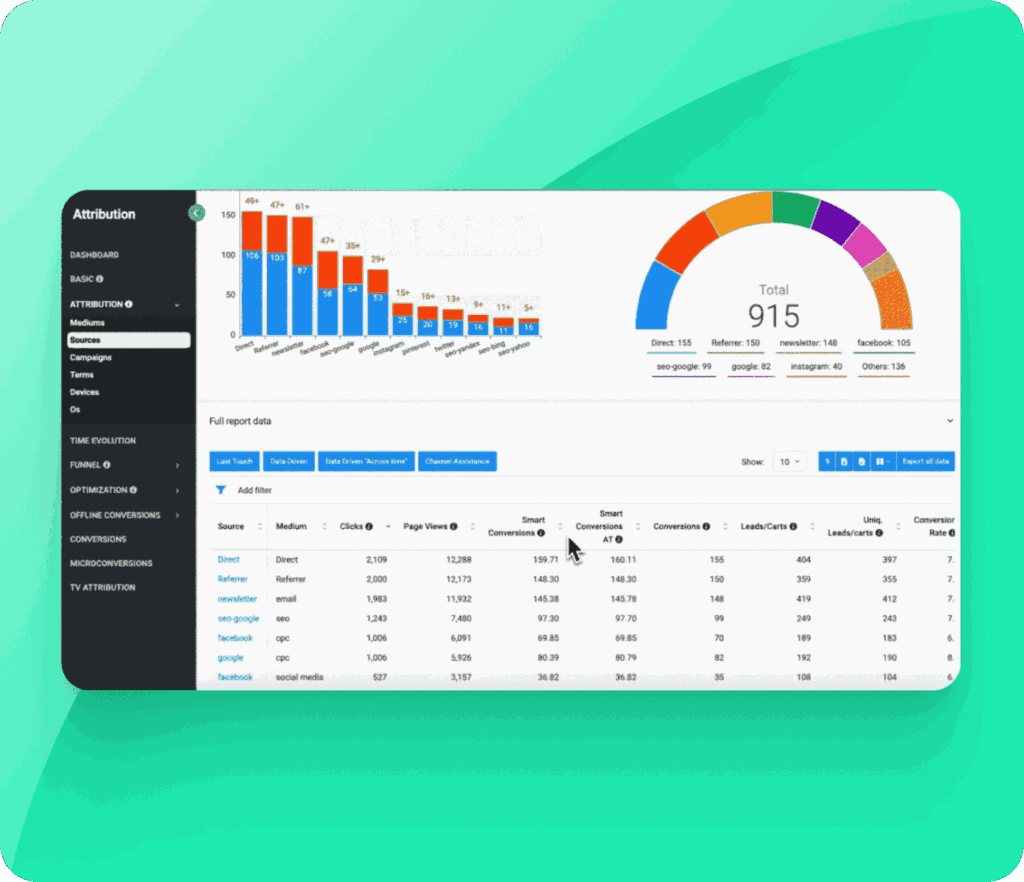
Challenge 2: Budget Constraints
Full-funnel marketing strategies can be expensive, especially as they involve multiple channels and touchpoints. The cost of developing content, paying for ads, and leveraging marketing tools for each stage of the funnel can add up to be very costly.
Solution
The best way to tackle budget-related issues is by prioritizing your spending on the most impactful funnel stages first. You can then gradually build out your strategy and expand to other stages as you go. Additionally, make sure to look for opportunities where you can leverage low-cost marketing strategies for small businesses.
If you lack the resources to manage your full-funnel marketing strategy in-house, consider outsourcing to an agency that specializes in it. But agency costs can quickly add up if you work with them based on hourly rates. Look for agencies that offer marketing packages to help you stick to your budget.
Challenge 3: Integration Across Platforms
With the customer journey becoming more multi-platform than ever, it presents a huge challenge for marketers to unify experiences across these platforms.
“The key challenge is ensuring any company’s message remains consistent throughout all stages in the funnel also integrating different marketing platforms for smooth transitions between them,”
says Pankaj Kumar, Director at Naxisweb.
Solution
Develop a cohesive multi-platform strategy that considers the role that each platform plays for different stages of the marketing funnel. You can also leverage solutions like Performance Max campaigns to holistically manage all your advertising campaigns across different platforms.
Conclusion
Having a full-funnel marketing strategy enables you to deliver a unified and consistent brand experience that improves brand recognition, brand-customer relationships, and conversions. Make the most of our detailed guide to understand the step-by-step process of developing your own full-funnel strategy.
Frequently Asked Questions
What is a full-funnel marketing strategy?
A full-funnel marketing strategy is a comprehensive plan that lays out the process of marketing your brand and products at every stage of the customer journey. It involves unifying the experiences across different stages of the marketing funnel, gradually easing customers through their path to purchase.
Why is a full-funnel marketing strategy important?
A full-funnel marketing strategy allows you to take a structured approach to guiding customers through the buying journey. It enables you to develop targeted content addressing the unique needs of customers at every stage of the marketing funnel. That way, you can provide value for every type of customer and drive conversions.
What are the main stages of a full-funnel marketing strategy?
The mains stages of a full-funnel marketing strategy are: Awareness (top of the funnel), consideration (middle of the funnel), conversion (bottom of the funnel). Some strategies also account for post-funnel experiences to nurture customers and boost loyalty.
What metrics should be tracked at each stage of the funnel?
The following metrics can help you understand your marketing performance at each stage of the funnel:
- TOFU: Impressions, reach engagement
- MOFU: Click-through rates, time on site, lead generation
- BOFU: Conversion rates, cost per acquisition, sales revenue
- Post-Purchase: Customer retention rate, customer lifetime value, net promoter score
How can I integrate a full-funnel strategy across multiple platforms?
You can integrate a full-funnel strategy across multiple platforms by first understanding how each platform contributes to the customer journey. Then aim to deliver value across all those platforms and unify the customer experience. Advertising solutions like Performance Max campaigns can also streamline the process by combining your campaigns and automatically promoting your brand through relevant channels.
